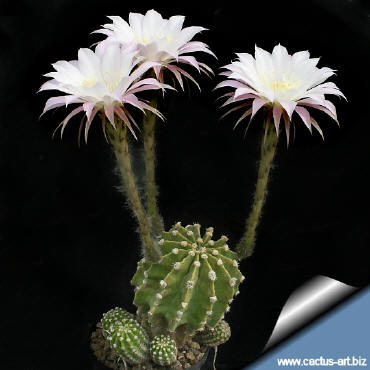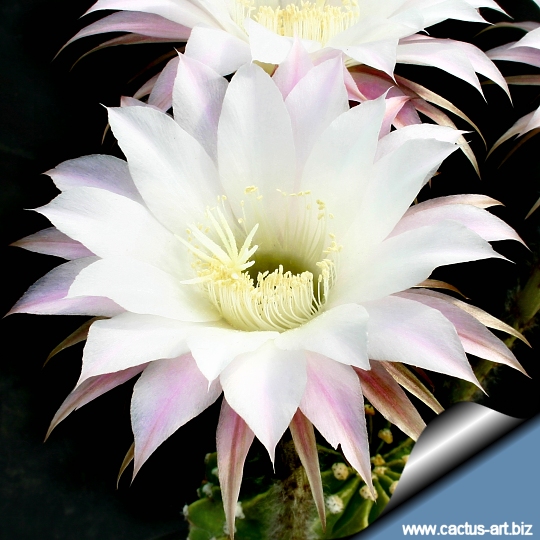|
|
|

The flowers of
Echinopsis oxygona are truly beautiful.
[Photo and plant by Massimo Giannelli Italy -
Click to enlarge]
 Description: the
stems is
globose to
elongate up to 30 cm high with 12- or 15-ribs.
The
areoles have 0,5-2,5 cm, curved, black-tipped brown
spines. Needs little water when established. Description: the
stems is
globose to
elongate up to 30 cm high with 12- or 15-ribs.
The
areoles have 0,5-2,5 cm, curved, black-tipped brown
spines. Needs little water when established.
These cacti grow rapidly and forms big
clumps up to 60 cm in diameter and produce gorgeous, night-blooming,
white-to-pink
funnel-shaped, fragrant flowers with long
tubes 15-20 cm long. Old plant may have dozen of stunning flowers
open at a time. This species
blooms from late spring to all summer long, the flowers open before
sunrise but last only one day in full beauty, at the second day they
start to wither. This plant has been widely
crossed with other
species of Echinopsis and the number of
cultivars seems unending. The flowers are lovely and are available
in an assortment of bright colours ranging from magenta, red, orange, to
yellow, and much sought-after by
Cactophiles everywhere.
 [
Echinops hybrids Thumbnail Picture Gallery] [
Echinops hybrids Thumbnail Picture Gallery]
|
Cultivation:
The Easter Lily cactus is a summer grower
species that offers no cultivation
difficulties. Water regularly in summer (but do not
overwater ) needs good drainage and very porous soil, keep rather dry
in winter.
Feed with a high potassium
fertilizer in summer.
It is quite frost resistant if kept dry (hardy to -7° C).
Need a bright exposure, full sun
or half shade in summer.
The cacti that love
hawkmoths pollination
Many species of cacti
utilize
hawkmoth pollination and depend on hawkmoths for successful seed
production. This species (Sphingophilous
plants) are easily recognized for the white
trumpet
nocturnal flowers (e.g., Echinopsis multiplex,
Acanthocereus tetragonus, and Hylocereus hundatus)
whereas others are more tubular (species of Selenicereus
and Stenocereus eruca). It is unlikely that only one
moth species is
pollinating only one flower species, so there will be mixed
pollen grains of many species on the insect. That notwithstanding,
hawkmoths are credited as fairly reliable long-distance
cross-pollinators because they are able to carry even small amounts of
pollen to isolated,
self-incompatible plants in tropical areas to produce fruits with
viable seeds.
Sphingophilous flowers are largely unused by other classes of
pollinators. These
nocturnal flowers are unavailable to day-active pollinators until
the next morning, and, in fact,
bees of various types sometimes arrive during morning hours to
accomplish an even higher level of pollination success.
|
|
Advertising
|
|
|
|
|
Family:
Cactaceae (Cactus
Family) Origin:
Bolivia, Argentina, Uruguay, and
Paraguay
Scientific Name:
- Echinopsis oxygona
(Link) Zuccarini ex Pfeiffer & Otto 1939
Conservation status: Listed in
CITES appendix 2.
Synonyms:
- Cereus oxygona Link 1830
- Cereus multiplex Peiffer
1837
- Echinopsis multiplex (Peiffer)
Peiffer & Otto 1839
- Echinopsis schwantesii
Fric 1927
- Echinopsis paraguayensis
Mundt ex f. Ritter 1979
Common Names: Easter Lily Cactus, Night-blooming Hedge-hogs
|
|
|
|
 |
|
Propagation: Direct sow after last frost, offsets.

 |
|